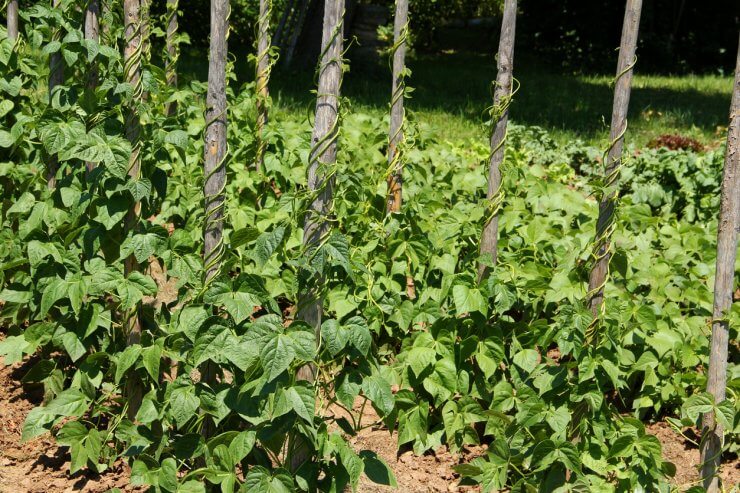Have you ever noticed when you’re cheating and buying your seedlings at a gardening center, how they never seem to label which beans are pole beans vs. bush beans? Each year I like to try growing new types of beans, and that part always gets me when I head into a leafy section of beans and I have to Google each bean name to find out whether it’s going to climb or bush out. My rule of thumb when this happens is that generally pole beans are marked as such, and bush beans are not. People love pole beans, so there are usually fewer of those available, too.

I’m part of the crowd that loves pole beans. I have trellises and they are so fun to cover in vines with anything edible on them. In that respect, there’s no competition for me in the debate of pole beans vs. bush beans, but some of the tastiest beans are grown in a bush only, like yellow wax beans—yum!
If you’re deciding what to grow, there are two basic types of green beans: bush beans and pole beans, also known as runner beans. As you might expect, bush beans are low growing and pole beans need support and grow tall. Here are some characteristics of each:
Bush beans:
- Grow 1 to 2 feet
- Prefer warm to hot weather
- Produce all at once (which is why they’re preferred for commercial, mechanical harvesting)
- Can be grown in gardens, raised beds, or containers
Pole beans:
- Grow vertically as runners or vines, typically 6 to 8 feet
- Need support to climb; teepees, tunnels, and other support systems add interest to the garden and are fun for kids
- Produce over a period of weeks, making them easy to harvest by hand
- Can be grown in gardens, raised beds, or containers
- Good choice if you have limited gardening space
Pole Beans vs. Bush Beans When Planting
When it comes to planting pole beans vs. bush beans, sow seeds 1 to 2 inches below the soil, 2 inches between plants for pole beans and bush beans. Once the seeds germinate, thin to 6 inches apart for bush beans and 3 inches for pole beans. If planting bush beans in rows, leave 18 inches between rows.
Pole Beans vs. Bush Beans Support
Pole or runner beans will need support in the form of bamboo poles, trellises, half hoops (for a tunnel), etc., which you should set in place when the shoots are about 4 inches high. If you’re planting pole beans to grow in a teepee fashion, use bamboo poles at least 7 feet tall and group 4-6 seeds at the base of each pole. Tie string around the poles to halfway up so the beans have something to grab onto on their way up. You might have also heard of runner beans, which are more or less pole beans. Bush beans don’t need as much support, they will simply bush out.
Pole Beans vs. Bush Beans in Containers
Bush beans and pole beans both grow well in containers. Because beans are a warm-weather plant, if your region has particularly cold springs where soil temperatures don’t warm up until late, container growing may be the solution. You can set the bean plants out for sun during the day and bring them in at night for protection until nighttime air temperatures are warm enough to keep them out overnight—65 to 85 degrees F.
Pole Bean vs. Bush Bean Companions
There are some plants that don’t play well with green beans. Pole beans and beets should not be planted together because they stunt each other’s growth. Bush beans and beets get along fine, though. Also, avoid planting green beans near members of the onion, or allium, family. Onions, scallions, garlic, and leeks exude a substance that kills beneficial bacteria on bean roots, stunting growth and blocking green beans from adding nitrogen to the soil. Sunflowers would seem to be perfect green bean companions, acting as poles like corn, but sunflowers give off a chemical compound that inhibits green bean growth. Both pole beans and bush beans can benefit from that advice. And on one last cheery note, pole beans growing near peppers can spread and latch onto the peppers, choking them, so avoid that too.
Pole Bean vs. Bush Bean Harvesting
Regardless of which type of green bean you grow, this rule applies: the more you pick, the more you get. Especially with bush beans, you will want to check every day for beans that are mature enough to pick. If you leave your green beans to keep maturing, you’ll lose crops two ways. First, without picking you won’t stimulate new pod growth. Second, green beans get their name because they should be harvested before they mature when they’re still young and “green.” Once they start to bulge with the seeds inside, they are no longer tender or tasty.
If you liked this article on Green Beans, we have a whole gardening guide on Green Beans that you will love. Looking for an easy crop that delivers a high yield, plenty of nutrition, and can make a statement in your garden? Grow green beans! Whether you choose tall-climbing pole beans or low-growing bush beans, the rule is: the more you pick, the more you get. It’s almost like magic! With our Grow Great Green Beans Gardening Guide, you get all the details that go into growing crisp, crowd-pleasing beans that practically grow themselves. Get recipes for dishes that make it all the more rewarding to grow your own beans. Get it all in the Grow Great Green Beans Gardening Guide right now!


 Previous
Previous

